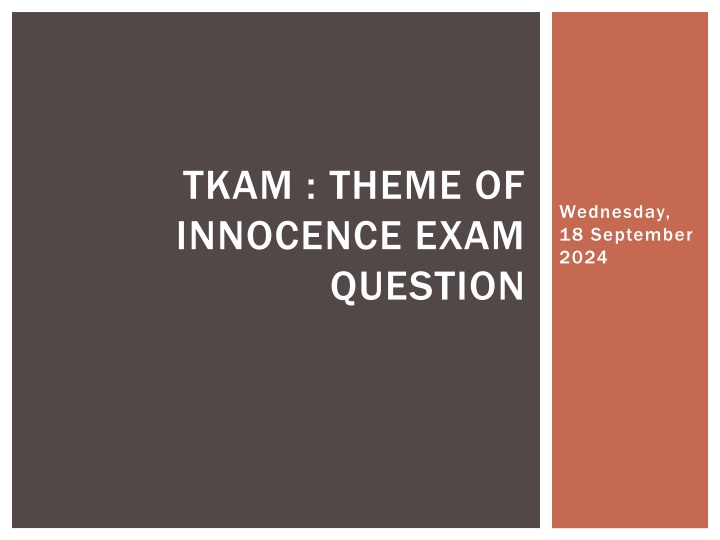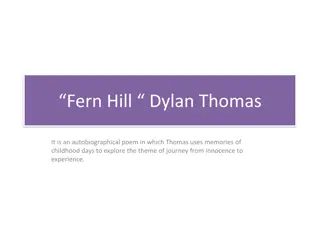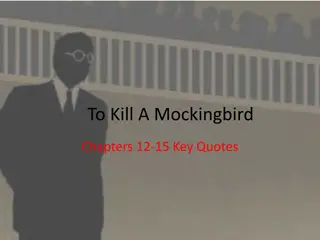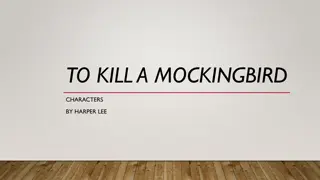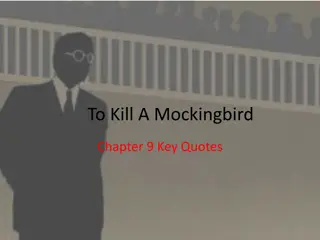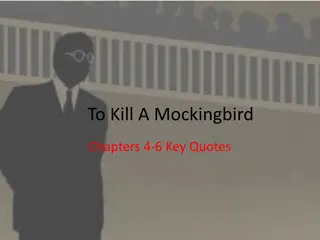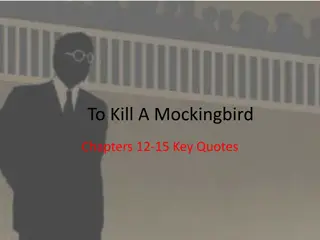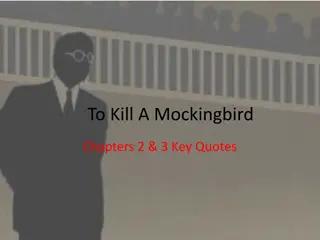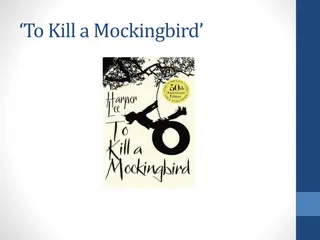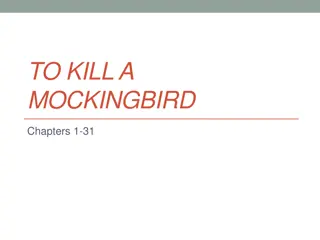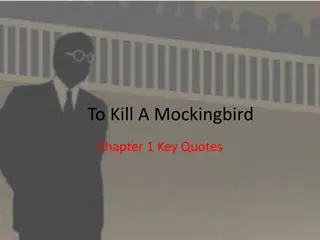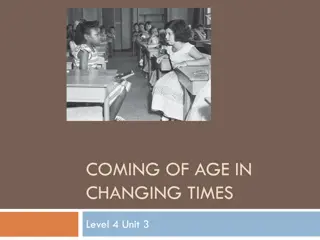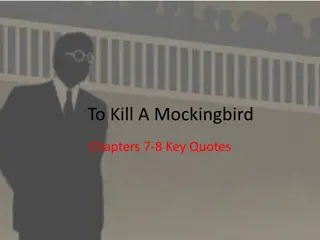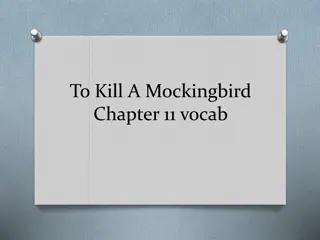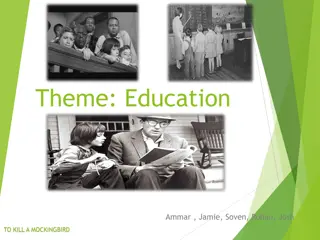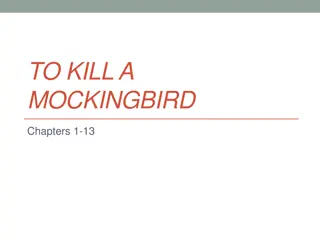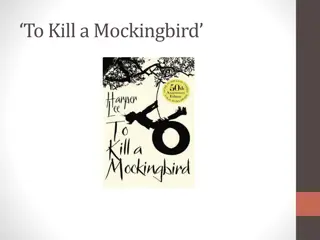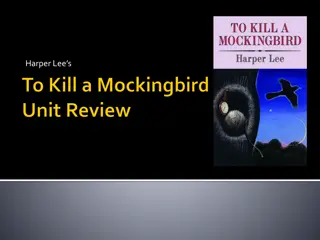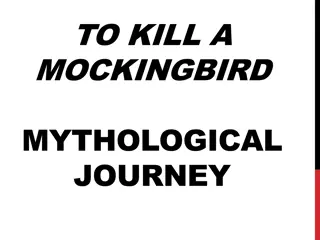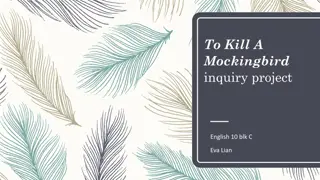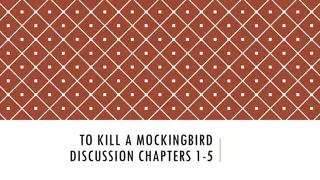Theme of Innocence in "To Kill a Mockingbird": Analysis and Discussion
Explore the theme of innocence in "To Kill a Mockingbird" through the development of characters from a state of innocence to experience, ethical and judicial innocence, and the portrayal of characters like Tom Robinson as symbols of innocence. Delve into the significance of innocence in societal norms and how it intersects with natural law to create a thought-provoking narrative that challenges perceptions of justice and morality.
Download Presentation

Please find below an Image/Link to download the presentation.
The content on the website is provided AS IS for your information and personal use only. It may not be sold, licensed, or shared on other websites without obtaining consent from the author.If you encounter any issues during the download, it is possible that the publisher has removed the file from their server.
You are allowed to download the files provided on this website for personal or commercial use, subject to the condition that they are used lawfully. All files are the property of their respective owners.
The content on the website is provided AS IS for your information and personal use only. It may not be sold, licensed, or shared on other websites without obtaining consent from the author.
E N D
Presentation Transcript
TKAM : THEME OF INNOCENCE EXAM QUESTION Wednesday, 18 September 2024
THE THEME OF INNOCENCE 2 strands to a good answer: Development from a state of Innocence to a state of experience in a Bildungsroman The natural/societal concept of innocence
DEVELOPMENT The children begin as innocents. How do they gain experience? Who provides the lessons? What specific lessons can you find? What is the significance of the breaking of the book into 2 Parts in this context?
FROM THE MARK SCHEME the children in the novel are presented in a state of innocence at the start of the novel. They harbour childish fears of Boo Radley, believing him to be a monster, but they gradually learn that he is a vulnerable man who is showing them kindness. They later become more worldly: for example, Scout learns self-control when she is insulted by her peers because her father is representing Tom Robinson and Jem learns to empathise after the incident with Mrs Dubose You can develop your thinking in the light of this paragraph. Always consider what other questions this might be used in.
ETHICAL AND JUDICIAL(SOCIETAL) INNOCENCE Symbolic Innocence It s a sin to kill a mockingbird The songbird symbolises innocence and key characters may be perceived as mockingbirds for their life-enhancing presence in the novel. Begin to work through characters who may apply
TOM ROBINSON Dignified and polite Respects the law and the court process Disabled and vulnerable scene in the Jail v- he needs protection Kind and generous. Consider his motives for helping Mayella. Capable of empathy and pity
FROM THE MARK SCHEME Tom Robinson is an innocent who is unprepared for the evil he encounters and as a result is destroyed. His innocent generosity in helping Mayella and pitying her is exploited and twisted when she falsely accuses him of rape. He is shot as he tries to escape from prison.
TOM 2 He is INNOCENT of any crime yet he is convicted This is seen with utter clarity by the reader The sense of INJUSTICE we feel is Lee s aim here. Natural Law: Innocent Societal Law: Guilty Why is it important in the light of this that Atticus is chosen to defend Tom, even though there is no chance of winning the trial in Maycomb?
BOO: A GENTLE INNOCENT When the children are very young he is depicted as the Gothic monster living in the house next door. As they grow they discover the truth Countless small acts of kindness present sin the tree, blanket Could be tried at the end of the novel Heck persuades Atticus against this Sets up an interesting question regarding Natural and Societal Law: In the opposite to Tom, at the end of the novel a guilty character is given natural justice and declared innocent .
DILL Slower to develop? Quite independent nature of his fatherless existence Full of wild imagination Still hurt and bemused a the trial allows for digression into Dolphus Raymond. The point? He has not had Atticus education to develop his experience. He can not bear to hear the manner in which Tom is being treated. He is still innocent.
ATTICUS DILEMMA A character wedded to the idea of JUSTICE above all Will consider giving his son up for trial Insists throughout the novel that people respect the rule of law Is fully aware that in tin letting Boo avoid trial he is placing Natural Law ABOVE societal law. Boo is AN innocent AN innocent. He is not innocent of the killing of Bob.
FROM THE MARK SCHEME Boo Radley is an innocent a shy loner; he is kept at home by his brother and is a neighbour of the Finch family. As the novel progresses, the children s changing attitude to him is an important measurement of their growth from innocence to a more mature perspective. Boo has suffered a cruel childhood but in spite of this he is good and in saving Jem and Scout from Bob Ewell he is the ultimate symbol of good.
BILDUNGSROMAN STRUCTURE the big question behind the novel about the innate moral nature of humanity is reflected in the dramatization of Scout and Jem s transition from childhood innocence to a more adult perspective. NB The narrator (adult Scout) is aware of this and has chosen a sequence of events to clearly show this progress. Can you list the incidents which help to outline this development?
